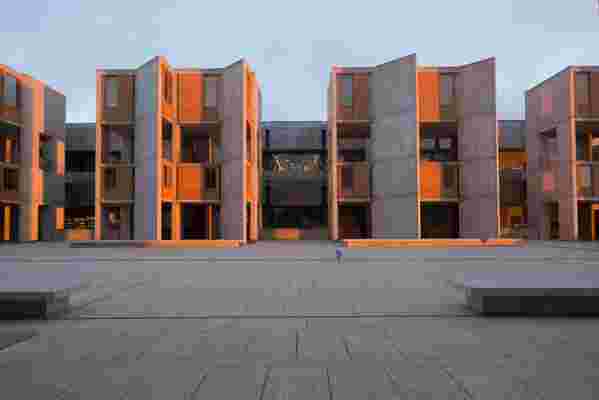Until just recently, one of the great masterpieces of modernist architecture, the Salk Institute , in La Jolla, California, has been shrouded by scaffolding. Designed by Louis Kahn, the institute was completed in 1965. It has been conducting a painstaking, four-year conservation of its iconic teak window walls, and now, with the scaffolding down and the building in full view, AD returned to La Jolla to check it out.
The wood—a Southeast Asian teak—was integral to Kahn’s design and to the client’s vision. Though the Salk Institute is just that—an institute—both its founder, Jonas Salk, and Kahn wanted the place to be a meditative retreat, where scientists could do laboratory benchwork but also have a place for study, contemplation, and even a bit of window-gazing. The wood spoke to that ambition, softening the concrete building and helping to create an environment, separate from the labs, where scientists could think.

Its oceanfront site makes for great views, but the damp, salty air took its toll on the wood. Water would wick into joints, allowing fungus to grow, and termites invaded moist areas of window frames. Because Kahn is known for his unrelenting perfectionism, one of the most offending outcomes of this deterioration was that the fungus did not grow evenly, creating different shades of gray and black.

The institute midrestoration, with scaffolding along the façade.
After making ad hoc fixes over the years, the Salk Institute determined it would approach its own architectural restoration the way it approaches scientific research: with empirical rigor. To do that, it turned to the Getty Conservation Institute and Wiss, Janney, Elstner Associates . GCI carried out a comprehensive analysis of the window wells, including historical research and testing in a laboratory and on mock-ups, all with an eye toward returning the wood to the way it was originally designed by Kahn.

“These are complex, elaborate assemblies,” explains Sara Lardinois, a project specialist for GCI, referring to the 203 individual window walls, each of which offers a different combination of sliding windows, louvers, and shutters, linked by custom woodwork.
After its analysis, GCI provided a restoration plan that could be customized for each window, based on the extent of the damage, from minor (cleaning and repair), to moderate (partial replacement of materials), to major (removing windows and replacing pieces with like-for-like materials). Because of the meticulous approach, the Salk Institute was able to restore window walls using mostly minor and moderate interventions, salvaging two-thirds of Kahn’s original teak.
